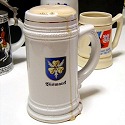
Report of the Commander in Chief, Navy, to the Führer on 26 April 1940 at 1500.
1. Raid by French destroyers on the night of 23 April in the Skagerrak.
Such raids by small destroyer units are always possible but have little prospect of success.
Defensive Measures:
a. Air reconnaissance in the evening, which will generally detect large-scale operations.
b. Mine fields only discourage destroyers, but do not always prevent their passage, since the destroyers may quite possibly pass them by using bow protection gear and by taking advantage of the dipping of the mines in the current.
c. Defense of the gap in the mine field by the 17 cm. battery at Hanstholm and the 21 cm. battery at Christiansand.
d. Radar gear is being set up in Denmark by the Navy and in Norway by the Air Force.
British destroyers have not ventured on such raids either in the German Bight or in the Skagerrak; French destroyers rely on their high continuous speed.
The French destroyers encountered patrol boats which fired on them; our torpedo boats were sent after them; naval aircraft squadrons and, finally, three planes of the operational Air Force were sent into action, so that the destroyers met real opposition.
The fact that we are carrying out heavy transport operations practically unmolested, in spite of not having naval supremacy, is to be attributed to geographical conditions and strong escort by naval forces and aircraft.
This escort service calls for the most intense and exacting operations of practically the whole Navy.
Re "b": Mine fields: Hanstholm-Christiansand 1,400 mines (at a depth of 3 m.) and 1,000 antenna mines (of these 400 laid); Skagen-Paternoster 1,000 submarine-laid mines; in addition flanking mine fields with 1,500 mines are planned as an extension of the Westwall.
Orders issued via the Commander in Chief, Luftwaffe, regarding use of a mine-laying squadron and of the He 59's for defense of the Skagerrak were unnecessary.
Minelayers are to be used offensively against Britain.
Laying of mines in Scapa Flow and the Clyde is as urgent as ever.
2. Submarine warfare. Small submarines must be withdrawn for training purposes; large ones must be used as soon as possible for submarine warfare against merchant shipping, which just now offers good prospects since large numbers of destroyers are operating in the north and the convoys are left unprotected.
Successes against fast, heavily escorted naval vessels on the Norwegian coast will be achieved only on rare occasions in spite of very large numbers of boats in operation.
Some submarines will remain in Norwegian waters (transport submarines).
The Führer agrees.
3. Defense of bases in Norway.
Fortification of Trondheim is of primary importance for the Navy.
Batteries, torpedo batteries, and nets are necessary.
Anti-aircraft guns are urgently needed.
Oslo, Trondheim, and Bergen have torpedo batteries; make-shift batteries should now be provided for Hardanger Fjord and Sogne Fjord (later Christiansand, Nord Fjord, and Andalsnes).
The Führer urges use of 38 cm. guns for closing the Skagerrak; these will not be ready until later.
The suggestion will be investigated.
The Führer urges use of the guns of the two coastal fortifications for the defense of the fjords, e.g., Sogne Fjord.
4. Anti-mine measures are at present of great importance.
A British aerial mine with acoustic firing has been found.
Therefore it is to be assumed that torpedoes used by submarines in the Skagerrak also have acoustic warheads; this is indicated by propellor hits.
The polarity of some of our mines has been reversed; a combination of both kinds is laid in order to insure their effect.
5. Cargo space. Of 2,400,000 tons, 1,000,000 tons have been taken over by the Navy; the rest comprises many large ships which cannot be used.
Therefore attempts should be made to use Danish and Norwegian ships.
There is a great demand for ore and coal transports.
The Russians, Swedes, and Danes will have to transport coal with their own vessels.
6. Decision regarding transport to Bergen. The five vessels carrying 1,800 men with equipment need not be sent; they should proceed via Oslo, since the situation around Bergen has been cleared up.
It is not necessary to use battleships for this purpose.
|
 BOOK: The Battleship Bismarck. The Complete History of the Ship.
 Naval & military gifts
|
